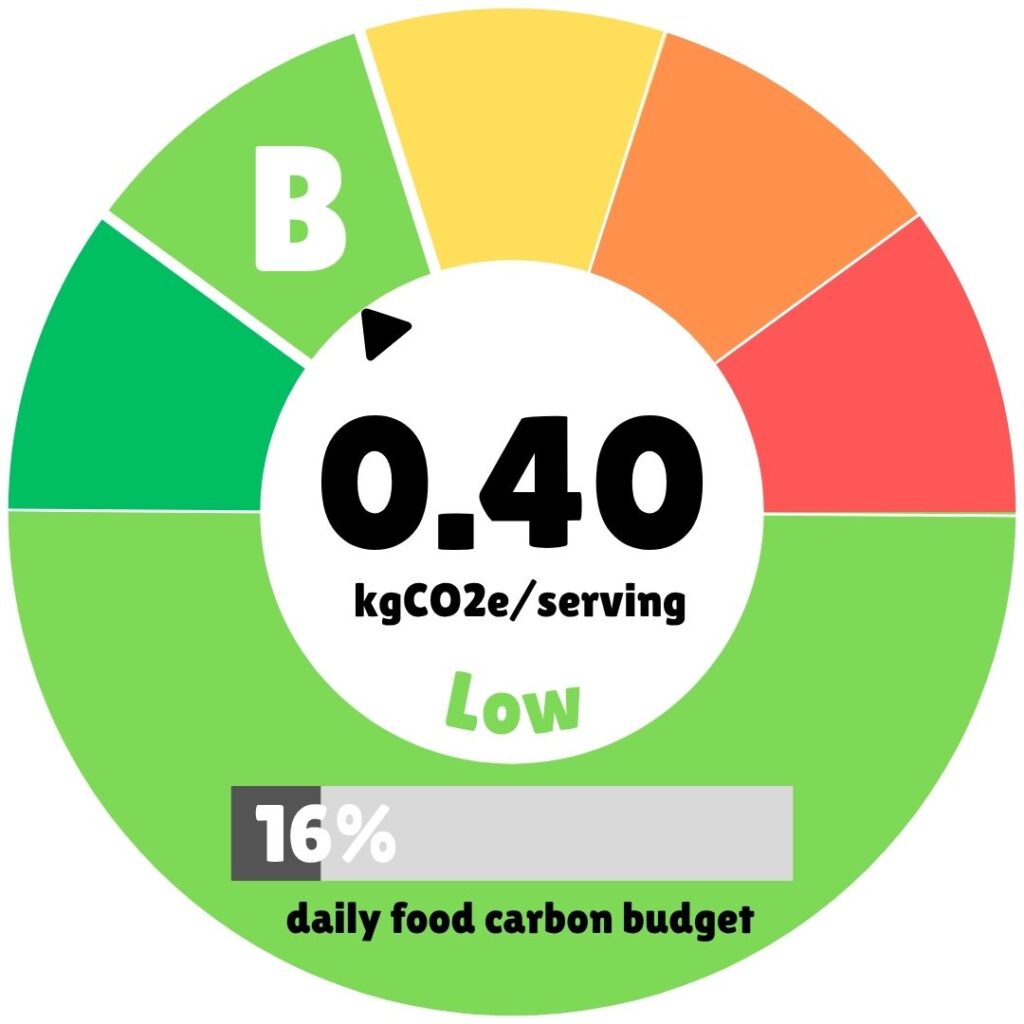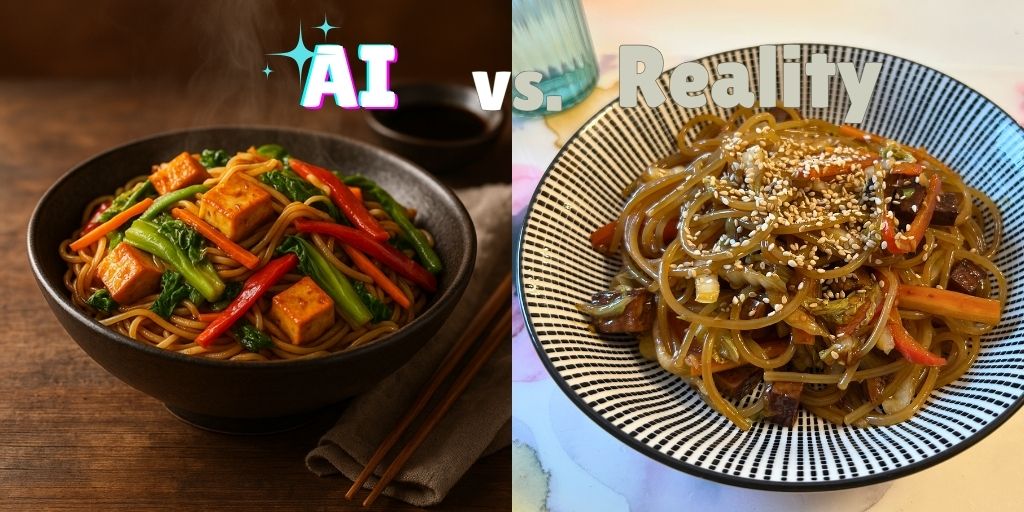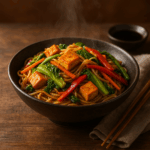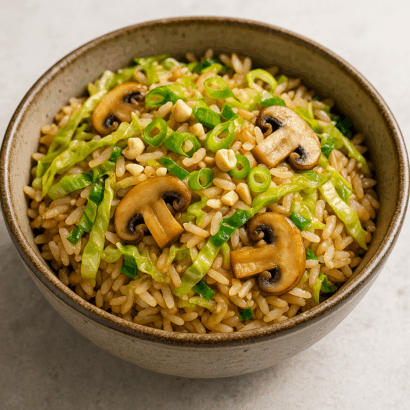Authors: Cobaia Kitchen, Magistral Medium, Claude 4.0 Sonnet
Photos: Cobaia Kitchen, GPT Image 1, Imagen 3.0 002
We set out to create a plant-based meal with a low carbon footprint, using ingredients easily found in German supermarkets. The challenge was to make something new and exciting with Chinese cabbage and rice stick noodles as the base, avoiding the usual suspects like chickpeas, tahini, and coconut milk that we’ve used plenty of times before. Stir-frying, a technique that dates back to the Han Dynasty in China, offered the perfect solution. It’s a method that cooks food quickly over high heat, preserving nutrients and flavors. Chinese cabbage, a vegetable cultivated in China for over 6,000 years, and rice stick noodles, a staple in Chinese cuisine, formed the foundation of our dish. For protein, we turned to tofu, another ancient Chinese ingredient that’s been a dietary staple since the Han Dynasty. We kept the seasonings simple with soy sauce, sesame oil, and a splash of rice vinegar to bring everything together. The result is a dish that’s not only quick to prepare—under 30 minutes of prep time—but also packed with flavor and nutrients. While your noodles soak, enjoy our funny story about a pair of Swedish Insta-chefs who took their “creative” Asian cuisine all the way to Beijing—with predictably disastrous (but hilarious) results. It’s a meal that’s gentle on the planet and perfect for a busy weeknight dinner.
Please read the review before cooking!
Chinese Cabbage and Rice Stick Noodle Stir-Fry with Tofu
Equipment
- Large wok or deep frying pan
- Knife and cutting board
- measuring cups and spoons
- mixing bowls
- Wooden spoon or spatula
Ingredients
- 300 g Chinese cabbage thinly sliced
- 200 g rice stick noodles
- 200 g firm tofu pressed and cubed
- 1 medium carrot julienned
- 1 red bell pepper thinly sliced
- 2 cloves garlic minced
- 1 tbsp ginger grated
- 2 tbsp soy sauce or tamari for gluten-free
- 1 tbsp vegetarian oyster sauce
- 1 tbsp sesame oil
- 1 tbsp vegetable oil
- 1 tbsp rice vinegar
- 1 tsp sugar
- 1/2 tsp red pepper flakes optional, for heat
- 2 tbsp water
- 1 tbsp cornstarch
- Salt and pepper to taste
- 2 tbsp chopped green onions for garnish
- 1 tbsp sesame seeds for garnish
Instructions
- Prepare the tofu by pressing it to remove excess water, then cut it into small cubes. In a bowl, mix together the soy sauce, oyster sauce, sesame oil, rice vinegar, sugar, red pepper flakes (if using), water, and cornstarch. Add the cubed tofu to the bowl and marinate for at least 10 minutes.
- Cook the rice stick noodles according to package instructions, usually by soaking in hot water for about 5 minutes until softened. Drain and set aside.
- While the noodles are soaking, prepare the vegetables. Thinly slice the Chinese cabbage, julienne the carrot, and thinly slice the red bell pepper. Mince the garlic and grate the ginger.
- Heat the vegetable oil in a large wok or deep frying pan over medium heat. Add the marinated tofu and cook until browned on all sides. Remove the tofu from the pan and set aside.
- In the same pan, add a bit more oil if needed, then add the garlic and ginger. Stir-fry for about 30 seconds until fragrant.
- Add the sliced vegetables (cabbage, carrot, and bell pepper) to the pan and stir-fry for about 3-4 minutes until slightly softened but still crisp.
- Add the cooked rice stick noodles and the cooked tofu back into the pan. Pour any remaining marinade over the noodles and vegetables. Stir-fry for another 2-3 minutes until everything is well combined and heated through.
- Season with salt and pepper to taste.
- Garnish with chopped green onions and sesame seeds before serving.
Notes
Serving suggestions:
Substitutes for vegetarian oyster sauce
- Hoisin Sauce: This is a sweet and salty sauce made from soybeans, garlic, vinegar, and spices. It’s thicker and sweeter than oyster sauce, so you might want to use a bit less and adjust to taste.
- Soy Sauce with a Touch of Sugar: Mix soy sauce with a bit of sugar or another sweetener to mimic the sweet-salty balance of oyster sauce. Start with 1 tablespoon of soy sauce and 1 teaspoon of sugar for every tablespoon of oyster sauce called for in the recipe.
- Teriyaki Sauce: This is a sweet and savory sauce made from soy sauce, sugar, and other seasonings. It’s thinner than oyster sauce but can provide a similar flavor profile.
- Mushroom Sauce: Some stores carry mushroom-based sauces that can be used as a substitute for oyster sauce. These are often made from shiitake mushrooms and have a rich, umami flavor.
Allergens:
- Soybeans (present in soy sauce/tamari and tofu)
- Sesame seeds (present in sesame oil and as a garnish)
- Check the ingredients of your oyster sauce or substitute
Emission Hotspots:
- The rice stick noodles represent the recipe’s primary carbon emission hotspot due to rice cultivation’s methane-intensive paddy farming
- Shop to home transportation, if a combustion car is used
Sustainability tips:
- Choose seasonal vegetables: Using what’s in season not only reduces the carbon footprint but also supports local agriculture and ensures peak freshness.
- Use up veggies: If you have vegetables in your fridge that are nearing their prime (like mushrooms, broccoli, or baby corn), add them to this stir-fry to prevent waste and boost nutrition.
- Walk or bike to the supermarket and farmer’s market to cut transportation emissions
- Soak the rice noodles in just enough hot water, then reuse the water for watering plants (after it cools).
- Compost peels and stems: After making your meal, compost any unavoidable food scraps to enrich your soil and reduce landfill impact.
- While your guinea pigs 🐹 will happily eat any remaining carrots, carrot greens and bell peppers, they may not be the biggest fan of cabbage. Use the remaining cabbage to make your own Kimchi, scale the recipe to make use of all cabbage (and freeze the rest) or look for another recipe.

Carbon Footprint


Featured Story
The Swedish Couple Who Stir-Fried a Nation

If you ever wondered how not to open a restaurant in Beijing, consider the tale of Ingrid and Sven from Karlskrona. Armed with four IKEA shelves, three online courses in “Fusion Cuisine,” and millions of Instagram followers adoring their “midnight sushi tacos” and “Viking soy latte bowls,” they decided to ride the Swedish wave of Asian culinary creativity straight to the Middle Kingdom. After all, if their Smörgåsbao received so many digital hearts, how could China resist their Scandinavian take on Chinese cuisine? How indeed.
Upon arrival, the pair immediately purchased matching panda aprons, believing this to be “great local branding.” In a whirlwind week of ambition, they rented a noodle shop in downtown Beijing, decorated it with Dala horses, and replaced chopsticks with engraved flatware (“the Chinese must be so tired of chopsticks,” Ingrid reasoned). Their pièce de résistance: Sven’s “Swedish Szechuan Cabbage Noodles with Pickled Herring Tofu.” Word spread quickly—mostly through WeChat memes. Diners were stunned into silence by the first mouthful, unsure if the burning sensation came from Szechuan pepper or the hint of licorice schnapps Sven had added in a fit of inspiration.
Reviews poured in from the hungry and the hapless. Food bloggers wrote about “the most inexplicable lunch in Beijing,” praising the entertainment value but warning: “Never has a dish inspired both homesickness for China and motion sickness at the same time.” The local expat group launched a blind tasting challenge—winner got to pick the music for the restroom playlist, which, due to a mix-up, had looped “Dancing Queen” for four days straight.
Ingrid and Sven, ever optimistic, declared the experiment a “resounding viral event.” Their Instagram exploded with new followers—most of them in Sweden, relieved to see the couple far, far away. The restaurant itself lasted only six weeks, but the legend of “the cabbage that cried at midnight” lives on at Beijing dinner parties everywhere. And for those who survived, the only thing more memorable than Ingrid’s wasabi lingonberry sauce was the day Sven attempted to demonstrate proper noodle-slurping technique to a table of diplomats, accidentally inhaling so vigorously that he launched a rice stick noodle directly into the Swedish ambassador’s wife’s hairdo—where it remained, dangling like a very limp exclamation point, throughout the entire cultural exchange dinner that followed.
Culinary Reality Check

This dish is a great choice for a stress-free evening, offering a delightful blend of flavors and ease of preparation. It’s one of the better AI-designed recipes, and I’d happily make it again. The only adjustment needed is the portion size.

Taste
The tofu absorbs the marinade beautifully, and there’s enough leftover to coat the noodles. The flavors are well-balanced and satisfying.

Portion Size
The recipe claims to serve three, but it’s closer to two. We managed since there were only two of us, but if you’re counting on leftovers for lunch, you might be disappointed.

Combination
The mix of noodles, veggies, and tofu works perfectly—nothing feels out of place.

Texture
The texture depends on your rice noodles. Ours were slightly firm even after following the package instructions, but that’s not the recipe’s fault. Everything else had the right bite.

Spices
The spice blend is spot-on. We used hoisin sauce instead of vegetarian oyster sauce, and it worked just as well.

Timing
The estimated 25-minute prep is generous, and the 15-minute cook time might be tight if your noodles need longer. Still, the whole dish comes together in 30-40 minutes, which is reasonable.

Processing
The instructions are clear, but here’s a tip: Don’t pour the marinade into the pan with the tofu (or worse, toss it out). You’ll need it later for the noodles—this wasn’t super clear in the steps.

Completeness
Everything you need is there—ingredients, instructions, and a well-rounded meal. No complaints.

Environment
The processed sauces and rice noodles add to the carbon footprint, but overall, it still earns a solid B for sustainability.

Health
A healthy, planet-friendly meal that aligns with the EAT Lancet diet, thanks to its plant-based focus and veggie content. For an even healthier twist, try whole-grain noodles and low-sodium sauces.

Tips for Redemption
- Save the marinade—it’s essential for the final step.
- Assume this recipe is for 2, and adjust amounts to your needs (count 100g of noodles per person)




